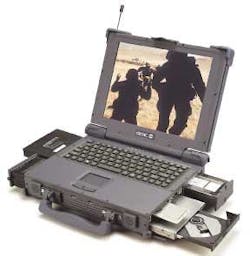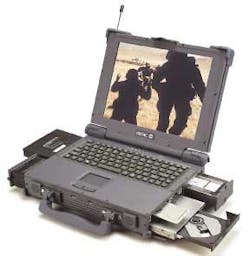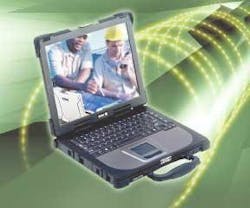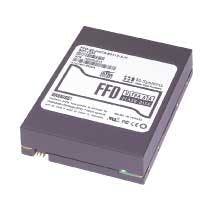Computer makers selling to military and aerospace systems integrators and field users understand the best design method involves modularity to accommodate a broad range of custom and off-the-shelf needs.
As Pentagon leaders strive to create the digital battlefield, they continue to place rugged computers in every vehicle, vessel, and aircraft. They will soon add computers to weapons, munitions, and soldiers, too.
The spread of computers throughout the battlefield makes major demands on components such as displays, keyboards, hard drives, boards, and processors.
The demands are even tougher on rugged computers when troops in the field pick a computer to match every mission.
The latest rugged computers are flexible enough to meet almost any application, using modular parts and bolt-on components, so technicians can build and repair them on the fly.
Keep it configurable
Users of rugged computers demand customized solutions, designed to fit the details of every job. Workers in a distant factory can take too long to customize a computer, so designers at General Dynamics are moving that process closer to the battlefield.
“We started with computers that were factory configurable, then depot-configurable, and now user-configurable,” says Chris Marzilli, vice president of commercial hardware systems for General Dynamics C4 Systems, Scottsdale, Ariz.
That means customers can configure their units to run applications such as a SPARC processor with Solaris operating system, Pentium processor with Windows or Linux operating system, or PowerPC processor with an embedded real-time operating system (RTOS).
For example, General Dynamics designers built a high-end, multiprocessing unit (MPU) to run the tactical operations center in a version of the U.S. Army UH-60 Black Hawk helicopter, called the Army aviation command and control system (A2C2S). That computer was depot-reconfigurable because it rarely left the aircraft.
Army leaders wanted to use it for a different job, so they asked General Dynamics to change the computer from depot-reconfigurable to field-reconfigurable. They now use the new MPU for their battle-command-on-the-move (BCOTM) system, in ground vehicles.
“It uses a more modular MPU, capable of field-level, not depot reconfiguration,” Marzilli says. “In a helicopter, the unit is basically buried in the bird, but in ground applications it is more accessible, and they use more of them. We are platform agnostic, so it is used on the Bradley and HMMWV, and soon on the Stryker.”
Rugged computer users are also demanding more memory space than ever before.
“Applications are demanding significant excess capacity; not just off-board storage, but swap space - the reserve gigabytes on a hard drive needed to do the application,” he says. “Your hard drive must be significantly larger than the data you will store, because applications need space to perform their operations.”
General Dynamics engineers nearly always use rotating hard drives for that rugged storage, he says. Solid-state flash memory is rugged, but that new technology still has high cost and limited capacity.
Computers with backpacks
As Pentagon leaders deliver computing power to every solider in a digitized battlefield, they will call for rugged computers to get more mobile.
The latest rugged computing platforms from General Dynamics include the embedded training module (ETM) used in Stryker vehicles for both training and missions. It will eventually serve as an interface for dismounted troops, using the commander’s digital assistant (CDA) in the Land Warrior vehicle integration kit (VIK).
The CDA family will have two members. The PDA machine is a personal digital assistant running the Windows CE operating system on a Hewlett-Packard iPaq computer. The NFF is a new form factor, using a tablet computer with touch-screen control to run Windows Tablet XP or Solaris x86.
Soldiers in the Land Warrior program will use these mobile computers for situational awareness, Identify Friend or Foe (IFF), and Force XXI Battle Command, Brigade and Below (FBCB2).
A crucial design aspect for either type of CDA is modularity, Marzilli says. Users will keep a single front-end interface, then add different modular “backpacks” if they need an option such as satellite communications, Iridium network, or global positioning system.
This modular design also enables technology refresh, lower costs, and simpler information technology work in the field, according to demands of the Army’s common hardware and software III (CHS3) contract.
Designers still face challenges to building field-configurable rugged computers. Soldiers must be able to change the hardware without tools, and use simplified components, so they don’t insert cables upside down. The components must shield their electromagnetic interference (EMI).
“That is the thing least understood by the commercial market,” Marzilli says. “Jamming of adjacent electronics could interfere with display function or radio range, according to MIL-STD 461.”
Wearable computers have a whole new set of design challenges. Most recent applications run on Intel or PowerPC processors, while existing applications often use the UNIX, and particularly Solaris, operating systems.
“So we’re committed to a heterogeneous environment. We must stay both processor- and form factor-agnostic,” he says. “That is partially because everything is connected to the GIG (global information grid), and partially because customers demand SWAP (size, weight and power).”
Weight and power are crucial aspects of wearable computers, since troops never want to carry heavy batteries or extra gear.
“We don’t want to overshoot the specs, unless they explicitly need spare slots, capacity, or environmentals,” he says. “The limiting agent for the soldier is power. So we’re looking at fuel-cell technology. It is still bolt-on now, but ultimately we will bake it into the device, and extend runtime to literally days.”
Designers at General Dynamics are now working on an Air Force contract for the battlefield air operations (BAO) kit, using a tablet computer fit with a fuel cell. Working with fuel-cell manufacturer Medis Technologies, New York, N.Y., they plan to deliver that unit by the end of 2005.
“It is a big deal because most soldier missions are three days away from reliable AC power, especially in places like Iraq. In a battlefield network, each computer is no stronger than its next closest link,” Marzilli says.
Avoiding over-design
Rugged computers are everywhere in today’s military, whether they are carried, mounted, embedded, or worn.
That presents a design challenge to engineers who must build those computers to handle nearly any task. Now a tool from Kontron America is making their job a little bit easier.
The Embedded Computer Module (ECM) is a sandwich-size computer that acts as a self-contained, rugged building block for military applications. Its main selling point is flexibility because the unit combines commercial off-the-shelf (COTS) components with a generic I/O port, so it can fit nearly any application.
“It has a simple 200-bit connector for I/O, so users design their own I/O on the other side; they can pick and choose for any platform,” says Dale Szymborski, president of Kontron America’s Mobile Computing Division in Eden Prairie, Minn.
Contractors can use it as a common denominator for various programs, so they get the products into the field faster, and avoid ground-up design.
null
null
“Think of the automobile; what we’re providing is an engine, and you can wrap any car body around it,” he says. “In the military world, you can’t survive meeting every possible demand. I/O choices vary with applications; a sniffer needs very little I/O, just a serial port, USB, video, and CAN. But FBCB2 needs a ton of I/O sticking out of the box, and a lot of it isn’t even used.”
That design speed is particularly important today, when troops demand equipment in the field fast, says Greg Ackerman, program solutions manager at Kontron. Computer designers no longer have time to design units from the ground up.
“That’s the hardest part: the enclosure and ruggedization, packaging, thermals, EMI, mounting. We’ve taken that out of the developers’ hands,” he says. “The I/O connection is easy; with a COTS or DIN connection to military pins you can do proof of concept in 60 days, and move to production in 90 days. That is light speed for ruggedized computer design.”
That flexibility allows rugged computer makers to build the right tool for the job, without adding extra weight.
“It seems the world is going to performance per watt, not pure gigahertz or clock speed,” Ackerman says. “And we take it a step further; performance per watt per size.”
Making piggyback computers
One way to customize rugged computers is to build them from separate processor and display modules.
This mix-and-match approach can add to the finished computer’s price and size, but it boasts benefits such as easier ruggedization, heat management, technology refresh, and customization.
For instance, the liquid-crystal display (LCD) is one of the most expensive and delicate components, says Moshe Albaum, an application engineer with Argon Corp. in Great Neck, N.Y. Argon engineers package the display in its own ruggedized compartment, then attach a “piggyback” compartment containing the processor. The method also lets them replace outdated processors to keep up with COTS suppliers.
Piggyback designs demand an open-architecture bus, so Argon designers choose ISA, CompactPCI, or PC/104 for most of their designs, he says.
Leaders at the U.S. Navy use Argon Corp. piggyback computers in applications such as the aircraft carrier USS George Washington (CVN 73).
They chose Argon because the computers are quiet, using convection instead of fans for heat management. And they can fit in small spaces by linking modules with cables instead of physical links, he says. Argon also builds computers for Sikorsky to install on its UH-60 and CH-53 helicopters.
Flexible computers handle several missions. Battlefield computers let commanders make decisions so fast that troops often do not have time to collect the right tools for each mission.
“What’s happening is missions are changing; they’re different day to day,” says Vladymir Rogov, vice president of marketing and design for Z Microsystems Inc. in San Diego. “They can’t plan and say this is what we’ll need. They need to load mission-specific software on the fly.”
So designers at Z Microsystems built the 4xMPU and 7xMPU - rugged computers than can run separate programs in a single box, then use a new motherboard in the field.
The 4xMPU computer holds any four motherboards, and enables them to share peripherals such as a USB port, floppy disk, or tape drive. Users can install a sealed computer module (SCM) for any particular job without returning to the lab.
Users include the U.S. Army, which has selected the 4xMPU for its FBCB2, combat services support control system, and command post platform, he says.
Army leaders also picked the 7xMPU for the A2C2S (Army airborne command and control system) in the Black Hawk helicopter. It allows them to run a collection of stovepipe applications in one box.
More important, those seven units come in sealed modules, including the motherboard. So to prepare the helicopter for a new mission, Army workers simply swap out seven motherboards, not the entire computer and chassis, he says. The system is modular, so if one board fails, they swap in a new part - not reboot all seven computers.
“You can’t predict what will happen next, but we know it will be smaller and faster,” Rogov says.
“The enemy is using cell phones and internet, which are state of the art. They’re using the fastest communication media in the world, while we have to go through classified equipment. So how do we keep it fast and current? This is a way; plug and play, off the shelf.”
High performance for rugged computers
Users of rugged computers need more than just a tough platform - they want blistering performance, too. Computer manufacturers are scrambling to add power without sacrificing mobility or ruggedness, says Scott Kongable, president of the Crystal Group in Hiawatha, Iowa.
Rugged computer makers have been choosing Intel x86 processors instead of Sun SPARC, he says. That approach lets them build “customized COTS” machines that take advantage of the low cost of open-architecture platforms while retaining environmental toughness in temperature, shock, and vibration.
“Customers say they get burned by configuration changes,” he says. “Six months after buying a system, they couldn’t get replacement motherboards anymore, so they had to use new ones and requalify the whole system.”
The move toward high performance can also cause a trend toward heat management problems. Faster processors make more heat, but using a larger heat sink adds weight and vibration. Some customers demand the performance of dual Intel Xeon processors. But processors slow down at high heat, so the machine could act like a slower Pentium III when it gets above 50 degrees Celsius, he says.
A third trend in high-speed rugged computers is the conflict between performance and size. Customers want their computers to be both faster and smaller.
Crystal engineers try to meet these challenges by acting as both computer designers and manufacturers, as opposed to simply assembling parts they buy from other companies. This focus on configuration management allows the company to stay flexible throughout the life of a contract, he says.
For instance, Crystal has a contract to refit computers aboard eight Ohio-class submarines. That job presents a technical challenge because the vessels will arrive in port over a period of three to five years. Computer technology will surely advance over that time, so Navy leaders could be forced to choose different components for the final vessels.
To avoid the problem, Crystal will store extra components today, allowing Navy leaders to choose between current and future technologies, he says.
The company’s latest product is a rugged telephony developer platform, designed for software companies making military communication systems.
The ITK100 IP Telephony Developer Platform acts as a rugged, stable platform where they can develop voice services. The development platform functions as both a digital VOIP gateway and an application server, all in a rugged 1U form-factor. That means developers can use it to build applications like call conferencing, IVR, unified communications, voice portal, voice recording, VoIP access gateway, and IP-PBX.
The ITK100 is based on Crystal’s MIL-STD 810F-certified CS100 1U rackmount server, containing a 2.4 GHz Pentium-4 processor, 512 megabytes of SDRAM, 40-gigabyte hard drive, CD-ROM, and AudioCodes’ IPM-260 telephony developer kit.
Building rugged screens
Users of rugged laptops want big screens and light weight. So designers at Getac, in Lake Forest, Calif., give their customers a choice. The company offers four product lines: the A770 (heavy duty, 14-pounds), the M220 (8 pounds), the W130 (lightweight, 6 pounds), and a tablet released in November.
The newest member of the family is the Mobile Force M220, which boasts a 14.1-inch screen, much larger than the usual 10.4- or 12-inch models. It runs an efficient Pentium M instead of the hot Pentium 4, and meets military standards from IP54 to 810F and MIL-STD 461.
And it offers options for every user, says Andy Ho, a Getac sales and marketing manager. Customers can customize the M220 with wireless 802.11 link, global positioning system, daylight viewable screen, removable CD-ROM bay, additional battery or hard drive, hard drive-based encryption, a solid-state hard drive, and a rubberized keyboard.
The most difficult design tradeoff in rugged computers is price versus display.
“Screen price is what’s keeping costs high; not the keyboard or drive,” Ho says. Even the weight of laptops is finally beginning to drop, thanks to factors like smaller hard drives (PCM-CIA or flash cards), materials (rubber, gel, or foam, dampers), and casing (tin, sheet metal, and magnesium).
Picking rugged memory
The head of a disk drive reads data as it rides on a cushion of air, just microns above the spinning hard-drive platter. The disk is destroyed if the two ever touch. That can be a recipe for disaster if that hard drive sits in the back of a HMMWV bouncing along a dirt road.
Still, many manufacturers choose to cushion their hard drives, citing the high cost and limited capacity of solid-state memory. Designers at M-Systems disagree.
“We see a trend in the last 12 months to incorporate solid-state flash disks in rugged computers,” says Ofer Tsur, vice president of marketing in the embedded division of M-Systems Inc. in Sunnyvale, Calif.
“As flash prices continue to go down and higher density of flash disks can be supported, many end customers are requesting flash disks. Most common flash disks used are with ATA interface using capacities of 8 to 20 gigabytes.”
Devotees cite several factors for their preference: flash disks are more rugged than mechanical disks, they offer better security features, they use one-third the power consumption, and they read data faster. Today’s best flash disks read and write data at 40 megabits per second, compared to 25 to 35 megabits per second for hard drives, Tsur says.
One major believer in the power of flash is the U.S. Army, whose leaders bought 800 solid-state drives from M-Systems in November to install in the Bradley fighting vehicle for the FBCB2 program.
Armey commanders will use FBCB2 to gain a clearer picture of where their forces are, using radio and satellite communications to continually update the battlefield picture based on input from individual soldiers. The user sees a map or an image as a background, illustrated with blue icons to represent friendly forces and red icons for the enemy. FBCB2 users can also send command and control messages to each other, either through preformatted joint variable message format (JVMF) messages or brief free-text messages.
Army leaders chose M-Systems’ FFD 2.5-inch Ultra ATA as the data storage embedded within ruggedized computers. Each solid-state disk has capacity up to 128 gigabytes, with performance of 100 megabits per second, and ruggedness of MIL-STD 810F - the specification to survive shock and vibration on a HMMWV, Bradley, Abrams tank, or helicopter. The disk also meets Pentagon and NSA standards for data sanitization.









